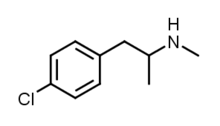''para''-Chloromethamphetamine
 | |
| Legal status | |
|---|---|
| Legal status |
|
| Identifiers | |
| |
| CAS Number | |
| PubChem CID | |
| ChemSpider | |
| ECHA InfoCard | 100.164.347 |
| Chemical and physical data | |
| Formula | C10H14ClN |
| Molar mass | 183.68 g·mol−1 |
| 3D model (JSmol) | |
| |
| |
para-Chloromethamphetamine (also known as 4-Chloromethamphetamine and 4-CMA) is a stimulant that is the N-methyl derivative and prodrug of the neurotoxic drug para-Chloroamphetamine.[1][2] It has been found to decrease serotonin in rats.[3][4][5] Further investigation into the long-term effects of chloroamphetamines discovered that administration of 4-CMA caused a prolonged reduction in the levels of 5-HT and the activity of tryptophan hydroxylase in the brain one month after injection of a single dose of the drug.[6]
Another study on rats found that 4-Chloromethamphetamine was more potent at inducing conditioned taste aversion than methamphetamine.[7]
4-Chloromethamphetamine was further investigated in the 1960s along with 4-CA and it was noted that they differed from their parent amphetamine and methamphetamine substances by exhibiting only a slight central stimulant effect in both animals and humans and that they acted like antidepressants rather than stimulants.[8][9][10][11]
See also
References
- ↑ Johnson MP, Conarty PF, Nichols DE (July 1991). "[3H]Monoamine releasing and uptake inhibition properties of 3,4-methylenedioxymethamphetaimne and p-chloroamphetamine analogues". European Journal of Pharmacology. 200 (1): 9–16. PMID 1685125. doi:10.1016/0014-2999(91)90659-E.
- ↑ R.W. Fuller; J.C. Baker; K.W. Perry; B.B. Molloy (October 1975). "Comparison of 4-chloro-, 4-bromo- and 4-fluoroamphetamine in rats: Drug levels in brain and effects on brain serotonin metabolism". Neuropharmacology. 14 (10): 739–746. PMID 1196472. doi:10.1016/0028-3908(75)90099-4.
- ↑ Kevin Sean Murnane; Shane Alan Perrine; Brendan James Finton; Matthew Peter Galloway; Leonard Lee Howell; William Edward Fantegrossi (April 2012). "Effects of exposure to amphetamine derivatives on passive avoidance performance and the central levels of monoamines and their metabolites in mice: Correlations between behavior and neurochemistry". Psychopharmacology. 220 (3): 495–508. PMC 3289749
 . PMID 21993877. doi:10.1007/s00213-011-2504-0.
. PMID 21993877. doi:10.1007/s00213-011-2504-0. - ↑ A. Pletscher; W.P. Burkard; H. Bruderer; K.F. Gey (November 1963). "Decrease of cerebral 5-hydroxytryptamine and 5-hydroxyindolacetic acid by an arylalkylamine". Life Sciences. 2 (11): 828–833. doi:10.1016/0024-3205(63)90094-8.
- ↑ Ray W. Fuller; C.W. Hines; J. Mills (April 1965). "Lowering of brain serotonin level by chloramphetamines". Biochemical Pharmacology. 14 (4): 483–488. PMID 14322972. doi:10.1016/0006-2952(65)90221-2.
- ↑ E Sanders-Bush; J A Bushing & F Sulser (January 1975). "Long-term effects of p-chloroamphetamine and related drugs on central serotonergic mechanisms.". Journal of Pharmacology and Experimental Therapeutics. 192 (1): 33–41. PMID 1123726.
- ↑ D.A. Booth; C.W.T. Pilcher; G.D. D'Mello; I.P. Stolerman (December 1977). "Comparative potencies of amphetamine, fenfluramine and related compounds in taste aversion experiments in rats". British Journal of Pharmacology. 61 (4): 669–677. PMC 1668069
 . PMID 597669. doi:10.1111/j.1476-5381.1977.tb07560.x.
. PMID 597669. doi:10.1111/j.1476-5381.1977.tb07560.x. - ↑ H. M. van Praagtory; J. Korf; F. van Woudenberg; T. P. Kits (July 1968). "Influencing the human indoleamine metabolism by means of a chlorinated amphetamine derivative with antidepressive action (p-Chloro-N-Methylamphetamine)". Psychopharmacologia. 13 (2): 145–160. doi:10.1007/BF00404812.
- ↑ Kits TP, van Praag HM (1970). "A controlled study of the antidepressant effect of p-Chloro-N-methylamphetamine, a compound with a selective effect on the central 5-hydroxytryptamine metabolism.". Acta Psychiatrica Scandinavica. 46 (4): 365–373. PMID 5502782. doi:10.1111/j.1600-0447.1970.tb02126.x.
- ↑ H. M. van Praag; J. Korf; F. van Woudenberg (December 1970). "Investigation into the possible influence of chlorinated amphetamine derivatives on 5-hydroxytryptamine synthesis in man". Psychopharmacologia. 18 (4): 412–420. PMID 4923523. doi:10.1007/BF00402767.
- ↑ H. M. van Praag; T. Schut; E. Bosma; R. van den Bergh (March 1971). "A comparative study of the therapeutic effects of some 4-chlorinated amphetamine derivatives in depressive patients". Psychopharmacologia. 20 (1): 66–76. PMID 5565748. doi:10.1007/BF00404060.